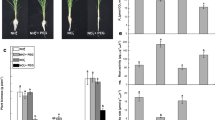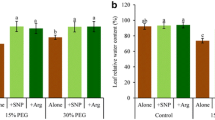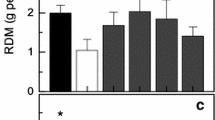Abstract
Drought stress can impair plant growth and development. Nitric oxide (NO), a gas signaling molecule, delays injuries caused by abiotic stress. This study explored the roles of NO during adventitious rooting in cucumber (Cucumis sativus L.) under drought stress. Our results found that 0.05% (W/V) polyethylene glycol 6000 (PEG) treatment significantly suppressed adventitious root formation, but 10 μM GSNO (a NO donor) treatment could significantly reverse the negative effect of drought stress. Under drought stress, MDA, H2O2 and O2·− accumulation were increased during rooting. Nevertheless, the application of exogenous NO decreased reactive oxygen (ROS) accumulation, revealing that NO might play an essential role in improving drought tolerance. Compared with PEG treatment, PEG + GSNO treatment enhanced the level of glutathione (GSH), ascorbic acid (AsA), and GSH/GSSG ratio, while decreasing glutathione disulfde (GSSG) content. In comparison with PEG treatment, PEG + GSNO treatment significantly increased the activity of antioxidant enzymes (APX, AAO, GR, and MDHAR) and the expression level of related enzyme genes (CsAPX, CsAAO, CsGR, and CsMDHAR). In addition, PEG + GSNO treatment also increased endogenous NO and S-nitrosothiol (SNO) content, nitrate reductase (NR) activity, and total S-nitrosylated proteins, and the expression of CsNR, while PEG + GSNO treatment decreased S-nitrosoglutathione reductase (GSNOR) activity, suggesting that protein S-nitrosylation might be involved in adventitious rooting under drought stress. In summary, our results indicate that NO could promote adventitious root formation under drought stress via regulating ascorbate glutathione (AsA-GSH) pathway cycle and protein posttranslational S-nitrosylation.









Similar content being viewed by others
Data Availability
Data are contained within the manuscripts or Supplementary Materials.
Abbreviations
- AAO:
-
Ascorbic acid oxidase
- APX:
-
Ascorbate peroxidase
- AsA:
-
Ascorbic acid
- AsA-GSH:
-
Ascorbate glutathione
- Con:
-
Control
- DAF-FM DA:
-
4-amino-5-methylamino-2’, 7’-diaminofluoresceindiacetate
- DW:
-
Dry weight
- FW:
-
Fresh weight
- FW:
-
Fresh weight
- GR:
-
Glutathione reductase
- GSNO:
-
S-Nitrosoglutathione
- GSNOR:
-
S-nitrosoglutathione reductase
- GSSG:
-
Glutathione disulfde
- H2O2 :
-
Hydrogen peroxide
- MDA:
-
Malondialdehyde
- MDHAR:
-
Monodehydroasorbate reductase
- NR:
-
Nitrate reductase
- O2 ·− :
-
superoxide anion
- PEG:
-
Polyethylene glycol 6000
- qRT-PCR:
-
Quantitative real-time PCR
- RWC:
-
Relative water content
- SNO:
-
S-nitrosothiol
- TW:
-
Turgid weight
References
Ahammed GJ, Choudhary SP, Chen S, Xia X, Shi K, Zhou Y, Yu J (2013) Role of brassinosteroids in alleviation of phenan-threne-cadmium co-contamination-induced photosynthetic inhibition and oxidative stress in tomato. J Exp Bot 64:199–213. https://doi.org/10.1093/jxb/ers323
Ahmad P, Ahanger MA, Alam P, Alyemeni MN, Ashraf M (2018) Silicon (Si) supplementation alleviates NaCI toxicity in mung bean [Vigna radiata (L.) Wilczek] through the modifications of physio-biochemical attributes and key antioxidant enzymes. J Plant Growth Regul 38:1–13. https://doi.org/10.1007/s00344-018-9810-2
Arora D, Jain P, Singh N, Kaur H, Bhatla SC (2016a) Antioxidant systems are regulated by nitric oxide-mediated post-translational modifications (NO-PTMs). Front Plant Sci 7:152. https://doi.org/10.3389/fpls.2016.00152
Arora D, Jain P, Singh N, Kaur H, Bhatla SC (2016b) Mechanisms of nitric oxide crosstalk with reactive oxygen species scavenging enzymes during abiotic stress tolerance in plants. Free Radica Res 50:291–303. https://doi.org/10.3109/10715762.2015.1118473
Chen L, Zheng F, Feng Z, Li Y, Ma M, Wang G, Zhao H (2021) A vacuolar invertase CsVI2 Regulates sucrose metabolism and increases drought tolerance in Cucumis sativus L. Int J Mol Sci 23:176. https://doi.org/10.3390/ijms23010176
Chen Y, Wang M, Hu L, Liao W, Dawuda MM, Li C (2017) Carbon monoxide is involved in hydrogen gas-induced adventitious root development in cucumber under simulated drought stress. Front Plant Sci 8:128. https://doi.org/10.3389/fpls.2017.00128
Corpas FJ, Barroso JB (2017) Nitric oxide synthase-like activity in higher plants. Nitric Oxide 68:5–6. https://doi.org/10.1016/j.niox.2016.10.009
Deng B, Deng S, Sun F, Zhang S, Dong H (2011) Down-regulation of free riboflavin content induces hydrogen peroxide and a pathogen defense in Arabidopsis. Plant Mol Biol 77:185–201. https://doi.org/10.1007/s11103-011-9802-0
Fan J, Chen K, Amombo E, Hu Z, Chen L, Fu J (2015) Physiological and molecular mechanism of nitric oxide (NO) involved in bermudagrass response to cold stress. PLoS ONE 10:e0132991. https://doi.org/10.1371/journal.pone.0132991
Feechan A, Kwon E, Yun BW, Wang Y, Pallas JA, Loake GJ (2005) A central role for S-nitrosothiols in plant disease resistance. P Natl Acad Sci 102:8054–8059. https://doi.org/10.1073/pnas.0501456102
Frungillo L, Skelly MJ, Loake GJ, Spoel SH, Salgado I (2014) S-nitrosothiols regulate nitric oxide production and storage in plants through the nitrogen assimilation pathway. Nat Commun 5:5401. https://doi.org/10.1038/ncomms6401
Fu H, Wei X, Chen Q, Yong S, Liu Q, Dang J, Wu D, Liang G, Guo Q (2023) Comparative transcriptome analysis of molecular mechanisms underlying adventitious root developments in Huangshan Bitter tea (Camellia gymnogyna Chang) under red light quality. Front Plant Sci 21:14–1154169. https://doi.org/10.3389/fpls.2023.1154169
Gomez MLP, Lajolo FM (2008) Ascorbic acid metabolism in fruits: activity of enzymes involved in synthesis and degradation during ripening in mango and guava. J Sci Food Agr 88:756–762. https://doi.org/10.1002/jsfa.3042
Gong B, Yan Y, Zhang L, Cheng F, Liu Z, Shi Q (2019) Unravelling GSNOR-mediated S-nitrosylation and multiple develop-mental programs in tomato plants. Plant Cell Physiol 60:2523–2537. https://doi.org/10.1093/pcp/pcz143
Gong W, Niu L, Wang C, Wei L, Pan Y, Liao W (2022) Hydrogen peroxide is involved in salicylic acid-induced adventitious rooting in cucumber under cadmium stress. J Plant Biol 65:1. https://doi.org/10.1007/s12374-021-09332-3
Guan L, Tayengwa R, Cheng ZM, Peer WA, Murphy AS, Zhao M (2019) Auxin regulates adventitious root formation in tomato cuttings. BMC Plant Biol 19:435. https://doi.org/10.1186/s12870-019-2002-9
Hamurcu M, Khan MK, Pandey A, Ozdemir C, Avsaroglu ZZ, Elbasan F, Omay AH, Gezgin S (2020) Nitric oxide regulates watermelon (Citrullus lanatus) responses to drought stress. 3 Biotech 10:494. https://doi.org/10.1007/s13205-020-02479-9
Hayat S, Hasan SA, Yusuf M, Hayat Q, Ahmad A (2010) Effect of 28-homobrassinolide on photosynthesis, fluorescence and antioxidant system in the presence or absence of salinity and temperature in Vigna radiate. Environ Exp Bot 69:105–112. https://doi.org/10.1016/j.envexpbot.2010.03.004
Heath RL, Packer L (1968) Photoperoxidation in isolated chloroplasts. I. Kinetics and stoichiometry of fatty acid peroxidation. Arch Biochem Biophys 125:189–198. https://doi.org/10.1016/0003-9861(68)90654-1
Hou L, Zhao M, Huang C, Wu X, Zhang J (2020) Nitric oxide improves the tolerance of pleurotus ostreatus to heat stress by inhibiting mitochondrial aconitase. Appl Environ Microb 86:e02303-e2319. https://doi.org/10.1128/AEM.02303-19
Hou X, Qi N, Wang C, Li C, Huang D, Li Y, Wang N, Liao W (2021) Hydrogen-rich water promotes the formation of bulblets in Lilium davidii var. unicolor through regulating sucrose and starch metabolism. Planta 254:1–16. https://doi.org/10.1007/s00425-021-03762-6
Hou Y, Yang Z, Gao L, Liu W, Liu R, Zhao J, You J (2017) Changes in element accumulation, phenolic metabolism, and antioxidative enzyme activities in the red-skin roots of Panax ginseng. J Ginseng Res 41:307–315. https://doi.org/10.1016/j.jgr.2016.06.001
Jin CW, Du ST, Zhang YS, Lin XY, Tang CX (2009) Differential regulatory role of nitric oxide in mediating nitrate reductase activity in roots of tomato (Solanum lycocarpum). Ann Bot-London 104:9–17. https://doi.org/10.1093/aob/mcp087
Jin X, Liao WB, Yu JH, Ren PJ, Dawuda MM, Wang M, Niu LJ, Li XP, Xu XT (2017) Nitric oxide is involved in ethylene-induced adventitious rooting in marigold (Tagetes erecta L.). Can J Plant Sci 97:620–631. https://doi.org/10.1139/cjps-2016-0156
Joshi M, Ginzberg I (2021) Adventitious root formation in crops-Potato as an example. Physiol Plantarum 172:124–133. https://doi.org/10.1111/ppl.13305
Kohli SK, Khanna K, Bhardwaj R, Abd Allah EF, Ahmad P, Corpas FJ (2019) Assessment of subcellular ROS and NO metabolism in higher plants: multifunctional signaling molecules. Antioxidants 8:641. https://doi.org/10.3390/antiox8120641
Kou N, Xiang Z, Cui W, Li L, Shen W (2018) Hydrogen sulfide acts downstream of methane to induce cucumber adventitious root development. J Plant Physiol 228:113–120. https://doi.org/10.1016/j.jplph.2018.05.010
Lee U, Wie C, Fernandez BO, Feelisch M, Vierling E (2008) Modulation of nitrosative stress by S-nitrosoglutathione reductase is critical for thermotolerance and plant growth in Arabidopsis. Plant Cell 20:786–802. https://doi.org/10.1105/tpc.107.052647
Li M, Yang Y, Raza A, Yin S, Wang H, Zhang Y, Dong J, Wang G, Zhong C, Zhang H, Liu J, Jin W (2021) Heterologous expression of Arabidopsis thaliana rty gene in strawberry (Fragaria × ananassa Duch.) improves drought tolerance. BMC Plant Biol 21:57. https://doi.org/10.1186/s12870-021-02839-4
Li SW, Zeng XY, Leng Y, Feng L, Kang XH (2018) Indole-3-butyric acid mediates antioxidative defense systems to promote adventitious rooting in mung bean seedlings under cadmium and drought stresses. Ecotoxicol Environ Saf 161:332–341. https://doi.org/10.1016/j.ecoenv.2018.06.003
Li XY, Liu X, Yao Y, Li YH, Liu S, He CY, Li JM, Lin YY, Li L (2013) Overexpression of Arachis hypogaea AREB1 gene enhances drought tolerance by modulating ROS scavenging and maintaining endogenous ABA content. Int J Mol Sci 14:12827–12842. https://doi.org/10.3390/ijms140612827
Li Y, Wu Y, Liao W, Hu L, Dawuda MM, Jin X, Tang Z, Yang J, Yu J (2020) Nitric oxide is involved in the brassinolide-induced adventitious root development in cucumber. BMC Plant Boil 20:102. https://doi.org/10.1186/s12870-020-2320-y
Liao W, Xiao H, Zhang M (2009) Role and relationship of nitric oxide and hydrogen peroxide in adventitious root development of marigold. Acta Physiol Plant 31:1279–1289. https://doi.org/10.1007/s11738-009-0367-3
Liao WB, Huang GB, Yu JH, Zhang ML (2012) Nitric oxide and hydrogen peroxide alleviate drought stress in marigold explants and promote its adventitious root development. Plant Physiol Bioch 8:6–15. https://doi.org/10.1016/j.plaphy.2012.06.012
Liu D, He S, Song X, Zhai H, Liu N, Zhang D, Ren Z, Liu Q (2015) IbSIMT1, a novel salt-induced methyltransferase gene from Ipomoea batatas, is involved in salt tolerance. Plant Cell Tiss Org 120:701–715. https://doi.org/10.1007/s11240-014-0638-6
Liu Y, Du Q, Bai L, Sun M, Li Y, He C, Wang J, Yu X, Yan Y (2021) Interference of CsGPA1, theα-submit of G protein, reduces drought tolerance in cucumber seedlings. Hortic Plant J 7:209–220. https://doi.org/10.1016/j.hpj.2021.02.003
Liu H, Wang C, Li C, Zhao Z, Wei L, Liu Z, Hu D, Liao W (2022) Nitric oxide is involved in hydrogen sulfide-induced adventitious rooting in tomato (Solanum lycopersicum). Funct Plant Biol 49:245–258. https://doi.org/10.1071/FP21288
Malik SI, Hussain A, Yun BW, Spoel SH, Loake GJ (2011) GSNOR-mediated de-nitrosylation in the plant defence response. Plant Sci 181:540–544. https://doi.org/10.1016/j.plantsci.2011.04.004
Niu L, Yu J, Liao W, Yu J, Zhang M, Dawuda MM (2017) Calcium and calmodulin are involved in nitric oxide-induced adventitious rooting of cucumber under simulated osmotic stress. Front Plant Sci 8:1684. https://doi.org/10.3389/fpls.2017.01684
Niu L, Yu J, Liao W, Xie J, Yu J, Lv J, Xiao X, Hu L, Wu Y (2019) Proteomic investigation of S-nitrosylated proteins during NO-induced adventitious rooting of cucumber. Int J Mol Sci 20:5363. https://doi.org/10.3390/ijms20215363
Pagnussat GC, Lanteri ML, Lamattina L (2003) Nitric oxide and cyclic GMP are messengers in the indole acetic acid-induced adventitious rooting process. Plant Physiol 132:1241–1248. https://doi.org/10.1104/pp.103.022228
Peng D, Wang X, Li Z, Zhang Y, Peng Y, Li Y, He X, Zhang X, Ma X, Huang L, Yan Y (2016) NO is involved in spermidine-induced drought tolerance in white clover via activation of antioxidant enzymes and genes. Protoplasma 253:1243–1254. https://doi.org/10.1007/s00709-015-0880-8
Prachi P, Jitender S, Murali A, Reddy MK (2015) Redox homeostasis via gene families of ascorbate-glutathione pathway. Front Env Sci 3:460. https://doi.org/10.3389/fenvs.2015.00025
Qi N, Hou X, Wang C, Li C, Huang D, Li Y, Wang N, Liao W (2021) Methane-rich water induces bulblet formation of scale cuttings in Lilium davidii var. unicolor by regulating the signal transduction of phytohormones and their levels. Physiol Plantarum 172:1919–1930. https://doi.org/10.1111/ppl.13401
Rai AC, Singh M, Shah K (2013) Engineering drought tolerant tomato plants over-expressing BcZAT12 gene encoding a C2H2 zinc finger transcription factor. Phytochemistry 85:44–50. https://doi.org/10.1016/j.phytochem.2012.09.007
Raja V, Qadir SU, Alyemeni MN, Ahmad P (2020) Impact of drought and heat stress individually and in combination on physio-biochemical parameters, antioxidant responses, and gene expression in Solanum lycopersicum. 3 Biotech 10:1–18. https://doi.org/10.1007/s13205-020-02206-4
Ren Y, Wang W, He J, Zhang L, Wei Y, Yang M (2020) Nitric oxide alleviates salt stress in seed germination and early seedling growth of pakchoi (Brassica chinensis L.) by enhancing physiological and biochemical parameters. Ecotoxicol Environ Saf 187:109785. https://doi.org/10.1016/j.ecoenv.2019.109785
Sehrawat A, Deswal R (2014) S-nitrosylation analysis in Brassica juncea apoplast highlights the importance of nitric oxide in cold-stress signaling. J Proteome Res 13:2599–2619. https://doi.org/10.1021/pr500082u
Skiba U, Smith KA, Fowler D (1993) Nitrification and denitrification as sources of nitric oxide and nitrous oxide in a sandy loam soil. Soil Biol Biochem 25:1527–1536. https://doi.org/10.1016/0038-0717(93)90007-X
Tichá T, Sedlářová M, Činčalová L, Trojanová ZD, Mieslerová B, Lebeda A, Luhová L, Petřivalský M (2018) Involvement of S-nitrosothiols modulation by S-nitrosoglutathione reductase in defence responses of lettuce and wild Lactuca spp. to bio-trophic mildews. Planta 247:1203–1215. https://doi.org/10.1007/s00425-018-2858-1
Tiwari S, Lata C, Chauhan PS, Nautiyal CS (2016) Pseudomonas putida attunes morphophysiological, biochemical and molecular responses in Cicer arietinum L. during drought stress and recovery. Plant Physiol Bioch 99:108–117. https://doi.org/10.1016/j.plaphy.2015.11.001
Wang P, Sun X, Li C, Wei Z, Liang D, Ma F (2013) Long-term exogenous application of melatonin delays drought-induced leaf senescence in apple. J Pineal Res 54:292–302. https://doi.org/10.1111/jpi.12017
Wang B, Bian B, Wang C, Li C, Fang H, Zhang J, Huang D, Huo J, Liao W (2019) Hydrogen gas promotes the adventitious rooting in cucumber under cadmium stress. PLoS ONE 14:e0212639. https://doi.org/10.1371/journal.pone.0212639
Wang CL, Wei LJ, Zhang J, Hu DL, Liao WB (2021) Nitric oxide enhances salt tolerance in tomato seedlings by regulating endogenous S-nitrosylation levels. J Plant Growth Regul. https://doi.org/10.1007/s00344-021-10546-5
Wei L, Wang C, Liao W (2021) Hydrogen sulfide improves the vase life and quality of cut roses and chrysanthemums. J Plant Growth Regul. https://doi.org/10.1007/s00344-021-10312-7
Werner T, Nehnevajova E, Köllmer I, Novák O, Strnad M, Krämer U, Schmülling T (2010) Root-specific reduction of cytokinin causes enhanced root growth, drought tolerance, and leaf mineral enrichment in Arabidopsis and tobacco. Plant Cell 22:3905–3920. https://doi.org/10.1105/tpc.109.072694
Xia H, Ni Z, Hu R, Lin L, Deng H, Wang J, Tang Y, Sun G, Wang X, Li H, Liao M, Lv X, Liang D (2020) Melatonin alleviates drought stress by a non-enzymatic and enzymatic antioxidative system in kiwifruit seedlings. Int J Mol Sci 21:852. https://doi.org/10.3390/ijms21030852
Xu XT, Jin X, Liao WB, Dawuda MM, Li XP, Wang M, Niu LJ, Ren PJ, Zhu YC (2017) Nitric oxide is involved in ethylene-induced adventitious root development in cucumber (Cucumis sativus L.) explants. SCI Hortic-Amsterdam 215:65–71. https://doi.org/10.1016/j.scienta.2016.12.006
Yu J, Su D, Yang D, Dong T, Tang Z, Li H, Han Y, Li Z, Zhang B (2020) Chilling and heat stress-induced physiological changes and microrna-related mechanism in sweetpotato (Ipomoea batatas L.). Front Plant Sci 11:687. https://doi.org/10.3389/fpls.2020.00687
Yuan HM, Huang X (2016) Inhibition of root meristem growth by cadmium involves nitric oxide-mediated repression of auxin accumulation and signaling in Arabidopsis. Plant Cell Environ 39:120–135. https://doi.org/10.1111/pce.12597
Zegaoui Z, Planchais S, Cabassa C, Djebbar R, Belbachir OA, Carol P (2017) Variation in relative water content, proline accumulation and stress gene expression in two cowpea landraces under drought. J Plant Physiol 218:26–34. https://doi.org/10.1016/j.jplph.2017.07.009
Zhang L, Li XW, Li XF, Zhou W, Han MY, Zhang LX, Li BZ (2016) Exogenous nitric oxide protects against drought-induced oxidative stress in Malus rootstocks. Turk J Bot. https://doi.org/10.3906/bot-1407-31
Funding
This work was supported by the National Natural Science Foundation of China (Nos. 32072559, 31860568, 31560563 and 31160398); the Fostering Foundation for the Excellent PH.D. Dissertation of Gansu Agricultural University (YB2022004); the Key Research and Development Program of Gansu Province, China (No. 21YF5WA096); the National Key Research and Development Program (2018YFD1000800); the Research Fund of Higher Education of Gansu, China (Nos. 2018C-14 and 2019B-082); the Natural Science Foundation of Gansu Province, China (Nos. 1606RJZA073, 1606RJZA077, and 1606RJYA252).
Author information
Authors and Affiliations
Contributions
The authors Weibiao Liao contributed to the study conception and design. Material preparation, data collection was performed by Xuemei Hou, Yuanyuan Dan, Nana Qi, Changxia Li, Yihua Li, and Yandong Yao, Xuemei Hou and Meiling Zhang were involved in the experiments and data analysis. Xuemei Hou wrote the first draft of the manuscript. Weibiao Liao revised the manuscript to present form. All authors read and approved the same for publication.
Corresponding author
Ethics declarations
Conflict of interest
The authors declare no conflict of interest.
Additional information
Handling Editor: Ravi Gupta.
Publisher's Note
Springer Nature remains neutral with regard to jurisdictional claims in published maps and institutional affiliations.
Supplementary Information
Below is the link to the electronic supplementary material.
Rights and permissions
Springer Nature or its licensor (e.g. a society or other partner) holds exclusive rights to this article under a publishing agreement with the author(s) or other rightsholder(s); author self-archiving of the accepted manuscript version of this article is solely governed by the terms of such publishing agreement and applicable law.
About this article
Cite this article
Hou, X., Dan, Y., Qi, N. et al. Nitric Oxide Promotes Adventitious Rooting in Cucumber Under Drought Stress Through Regulating Ascorbate Glutathione Cycle and Protein S-Nitrosylation. J Plant Growth Regul (2024). https://doi.org/10.1007/s00344-024-11304-z
Received:
Accepted:
Published:
DOI: https://doi.org/10.1007/s00344-024-11304-z




